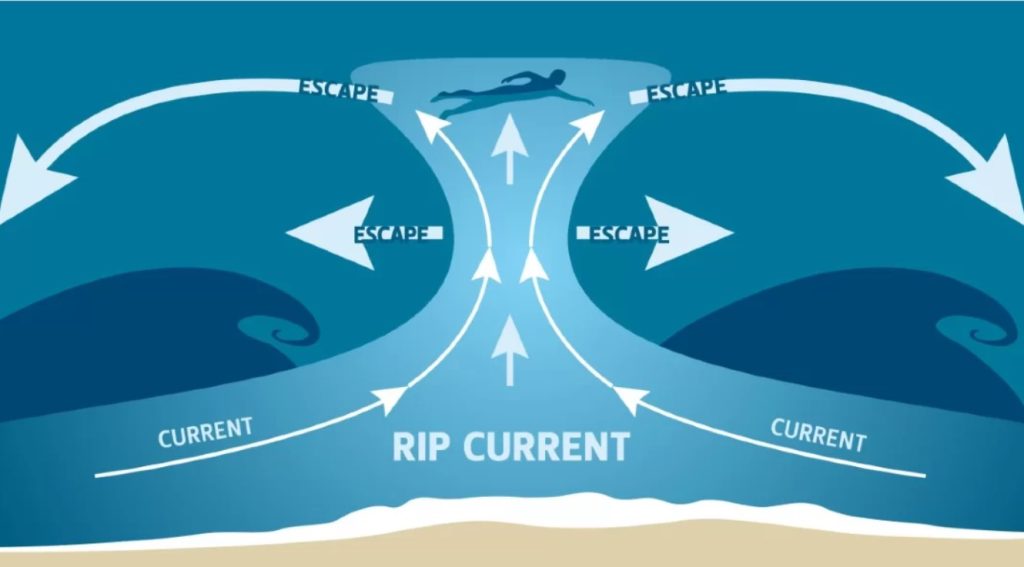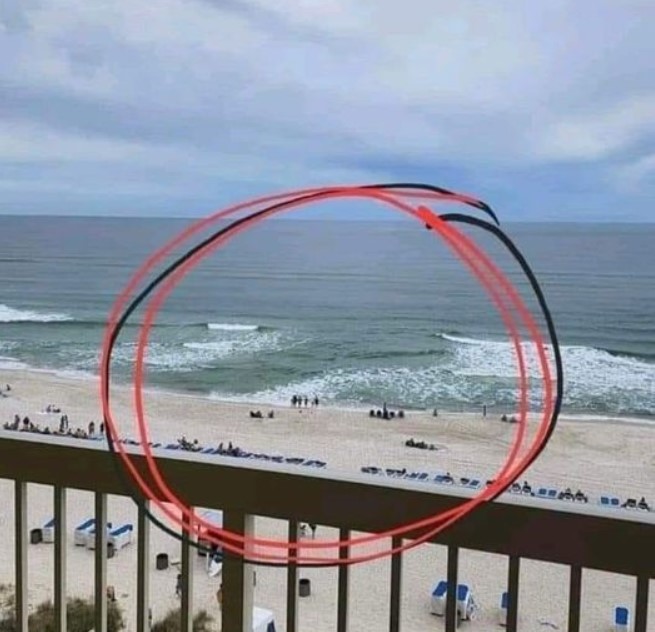One of the fun things about the beach is watching and playing in the waves, which were likely made by wind hundreds of miles away. These waves travel long distances in deep water before they get to the beach. As the water gets shallower, the waves slow down and steepen, until they eventually topple over and “break.” Breaking waves trap lots of air bubbles in the water, making the water look white and foamy, called whitewater. Most of this wave breaking occurs in an area called the surfzone—because this is where you can actually catch the waves and surf!
As the whitewater moves toward the beach, it does not just keep piling up at the beach (or else the whole beach would be underwater!), but instead, the water flows back offshore—thanks to strong, narrow currents called rip currentsA strong offshore flow of water at the beach that is hazardous to people.. While there are several different types of rip currents, most are just like rivers—they flow in deeper channels between shallow sandbarsUnderwater mounds of sand that come in different shapes and sizes, often with deeper channels running through them.. Sandbars are underwater mounds of sand that come in different shapes and sizes, often with deeper channels running through them. Rips are formed by the action of breaking waves, and sand bars play an important role in this. Since waves mostly break in shallow areas, there is a lot of wave breaking and whitewater across sand bars, but not as much across the channels, where the water is deeper. This means that the easiest way for water to head back offshore is through the deeper channels and that is where most rip currents form
Don’t confuse a rip current with an undertow. Rip currents are much more dangerous, because they flow on the surface of the water, can be very strong, and can extend some distance from the shore. An undertow can occur when water sinks back downhill into the sea after a wave has carried it uphill onto the beach. Unless the beach has a steep incline, the undertow will probably not be very powerful. However, if the tide is high, the wave is large, and the beach slopes sharply downhill toward the water, the undertow could be strong enough to knock you down, but it won’t carry you far—maybe just far enough to get smacked by the next big wave coming in.

You might have heard of something called “rip tides,” but this term is incorrect. Rip currents have nothing do with the tides, which are caused by the gravitational pull of the Moon on the whole ocean. Rip currents, on the other hand, are a purely local effect.
Rip Currents Dangerous?
Even in nice weather conditions, rip currents can flow offshore through these channels very quickly, sometimes at speeds of over 2 m (2.2 yards) a second, which is as fast as some Olympic swimmers! This means that even gentle rip currents can take swimmers of all abilities a long way offshore. A rip current can easily move someone the length of a football field in just 1 min. What makes these currents dangerous is that you do not feel anything, you are just going with the flow. It is only when you realize that you are suddenly a long way from the safety of the beach that things get scary, and that is when most people start to panic. When people panic, they often try to swim back to the beach against the current and, in doing that, there is a risk they will use up all their energy.
Unfortunately, it is very common for people to get caught in rip currents on beaches around the world and most rescues that beach lifeguards perform involve saving people caught in rips. This means that tens of thousands of people are caught in rip currents every year. If it was not for the lifeguards, the number of drownings would be terrible. So, why are so many people getting in trouble in rip currents? Because they either did not swim near lifeguards, did not know how to spot a rip current, or did not even know what a rip current was, or how it worked.
You can look for patches of calm water between breaking waves, or the offshore movement of debris and sediment. If you are caught in a rip current, relax, float, and remember that it would not pull you under the water. Instead, you can raise your arm to signal for help, stay afloat, and slowly swim toward the breaking waves on either side of the current to help you get back to shore. Of course, the best way to stay safe at the beach is to always swim near a lifeguard.






